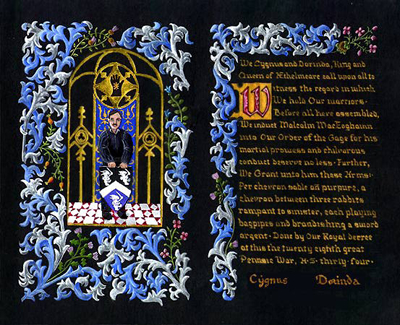SCA scrolls on colored paper.
This page has been provided as a teaching tool.
Feel free to come back here and visit often,
but please do not borrow or reuse the artwork without written permission.
All rights remain with the originators of the work.
Notes on using colored papers.
Dyed vellum was sometimes used in medieval manuscripts and is still available from some vellum merchants. You will need to do further research on your own to see which colors are appropriate for any particular time or region.
The effects of time and exposure to sunlight on these materials vary. To test for color stability use several paperclips to place a 3 x 5 card over one side of a piece of colored paper. Allow this to sit in a window for 2 weeks to a month. Remove the card and compare the 2 areas. You will be able to see the effects of sunlight on the paper you've chosen.
 |
Calligraphy by His Lordship, Aengus MacBain |
| , |
Overall size 8 x 10 inches |
This scroll is an example of a Gage (AEthelmearc Order of High Merit for heavy weapons fighting). It is done on archival quality black paper from a scrapbooking store. Apprximate weight #90. The layout and calligraphy lines were done in dressmakers pencil. The illumination was painted with a combination of period pigments and gouache. Both color sources had glair added as a binder and to maintain a consistent sheen. The calligraphy was done using a .5 Brause nib and shell gold. When the scroll was finished, any lines still showing were removed with a white eraser. |

Here is an example of a Sigil scroll awarded to a household (Hus Faerhaga - whose badge is the hawk). Sigils are an Ęthelmearc award given for service to the Coronet during a reign.
Overall size 11x14 inches
Calligraphy and illumination by
Baroness Juliana Richenda Trevain.
This scroll was done on a 100# commercial black paper that has a linnen weave. Because the paper was black, eraser marks were very easy to see so a minimum of pencil had to be used. The hawk and sigil are templates of previous drawings that were traced to leave an impression in the paper (rather than pencil lines) and then inked over. Removing the pencil guide lines for the calligraphy created a slight - and I do mean slight - dulling of the paper that vanished after a few hours.
The ink used for the calligraphy on this piece is an opaque white paint which has been watered down to allow it to flow from the nib of a dip pen. It's called "Pro-White" manufactured by Daler Rowney. 29.5 ml jar for just under $6.00. The label describes it as "Process White - opaque watercolor. For use on paper, acetate and negatives. Use with brush, pen and air-brush. Stir well."
Since the paint is water soluble, it does pick up some under color which comes in handy to shade but it dries very quickly. Especially when used on a calligraphy pen which is what I used - no brush, not even the Sigil background, all pen. Which translates to - clean the pen very often to prevent build-up.
Return to the scroll examples.
 MAIN PAGE.
MAIN PAGE.